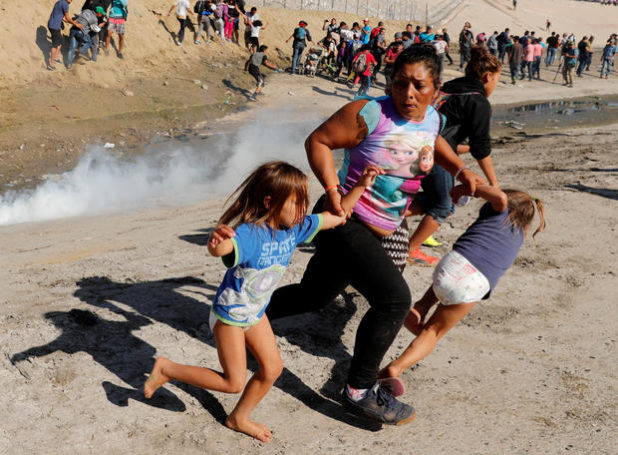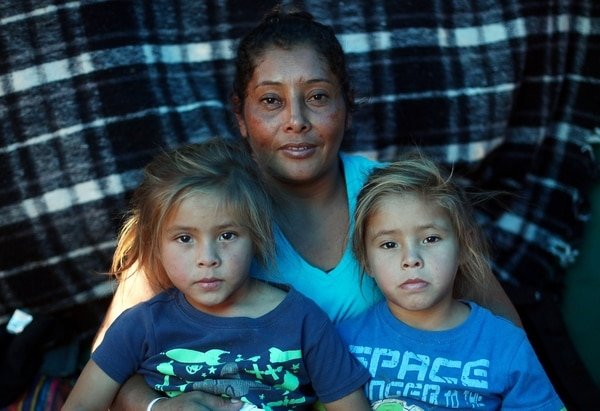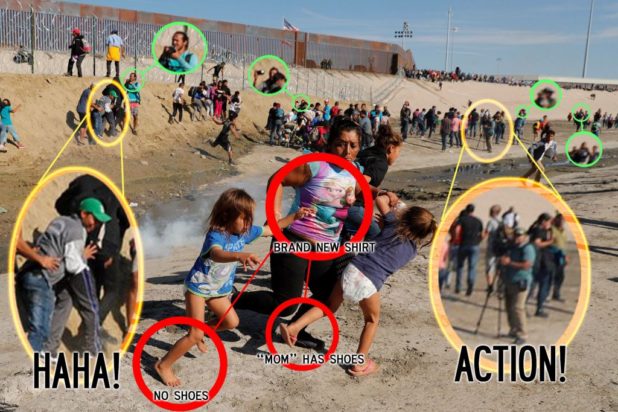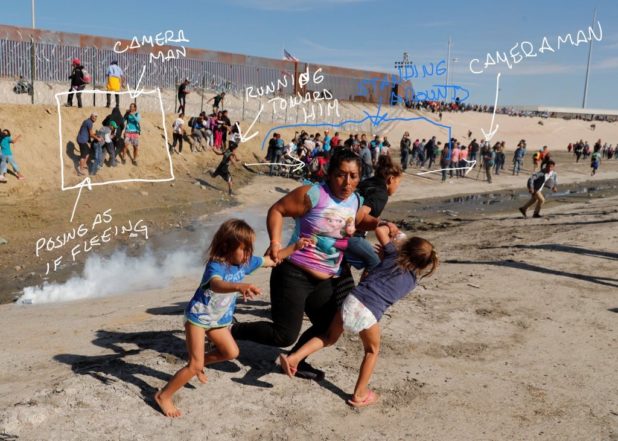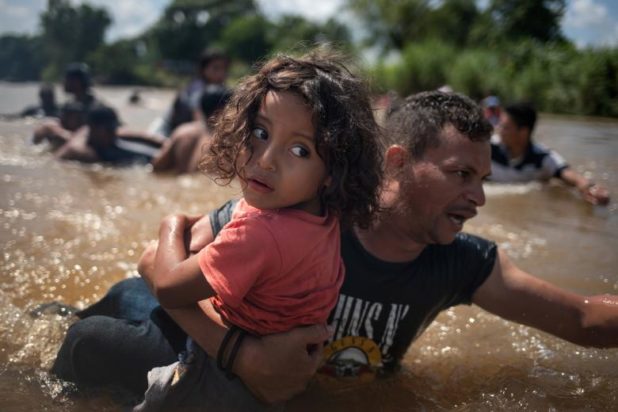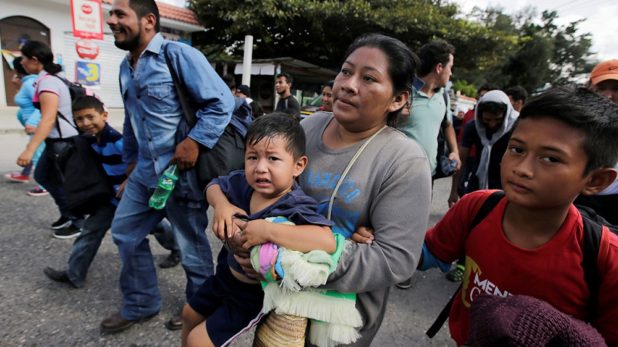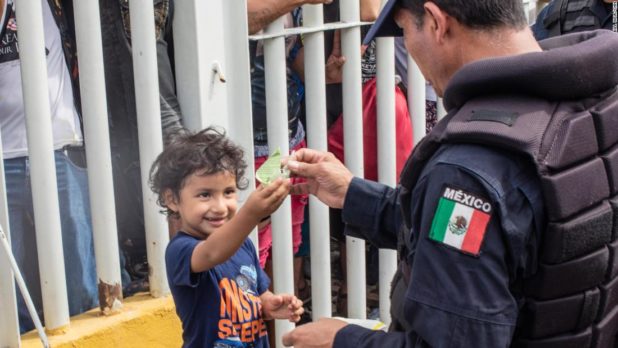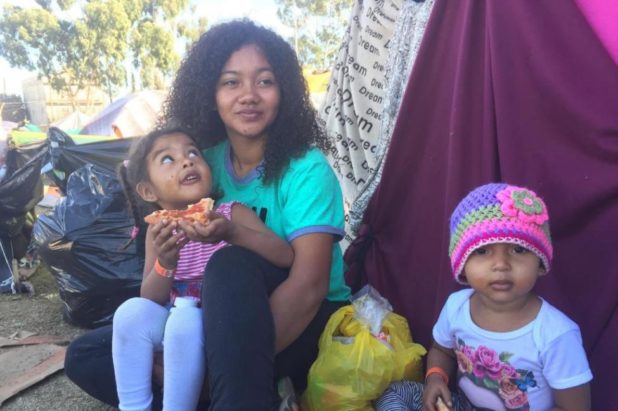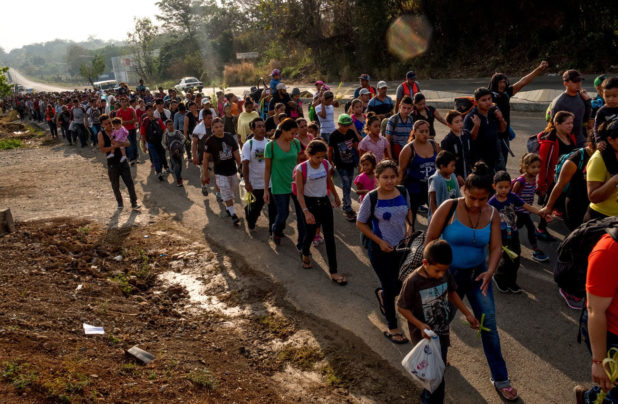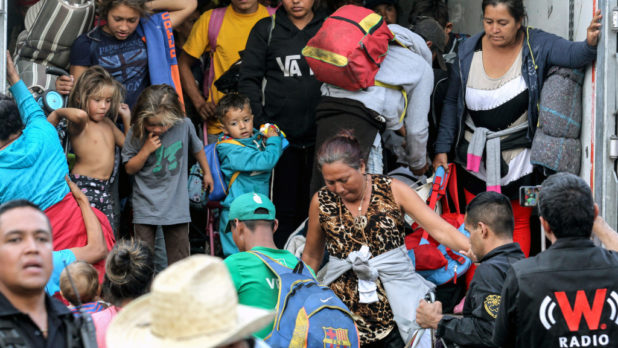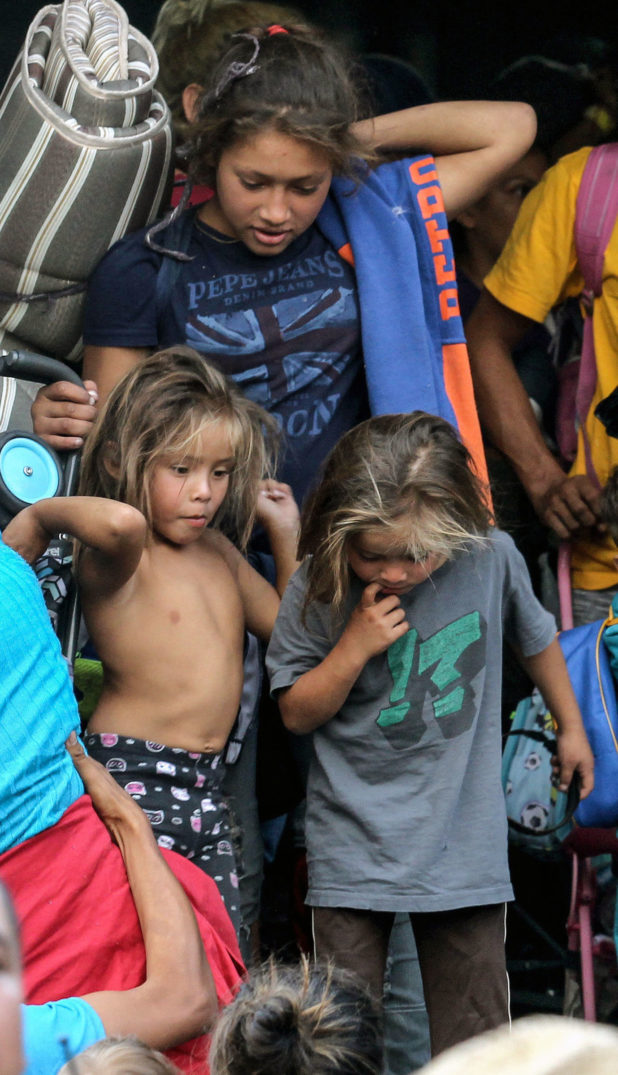Octavio Rivera
Daily Stormer
November 30, 2018
The recent attack on the U.S. border by part of a caravan stationed in Tijuana yielded viral pictures of a mother and her little kids escaping tear gas shot by American agents in response to the migrants throwing rocks and trying to force their way in through the fence.
These pictures raised some eyebrows after the scrutiny of the public.
The first and obvious thing that was pointed out is that the kids don’t match the mother.
Clear physical differences.
Although the twins could be the daughters of the woman from the pictures despite the blunt discrepancy in their looks, perhaps-more-serious details were pointed out about the now famous scene.
After a light examination of the high-resolution pictures, it is hard to argue against the idea that the alleged family portrayed as escaping a gas attack by U.S. soldiers was actually posing for the camera as were multiple others captured in some of the shots.
Nevertheless, the media fact-checked the claim that the whole thing was a hoax and claimed that those were legit photographs, even though the details pointed out by people all over the internet —such as the fact that you can see tripods, photographers, groups posing, other people chilling and standing, and no sense of urgency in the rest of the crowd— were not addressed.
True or false, the claim that the picture was staged prompted further investigation into the subject.
My findings suggest there is good reason to believe it was staged.
The following is an overview of the evidence that I’ll cover in this article to support my claim:
- The story of Maria Meza, the alleged mother, is inconsistent across multiple news outlets.
- The people behind this selected light-skinned kids to elicit white people’s empathy. The twins are outliers among the caravan’s kids.
- The twins don’t really wear diapers and are at least 5 years old according to sources.
- People in the caravan use children even if they’re not related to make it easier to get into the U.S, sometimes even buying them. This is child trafficking.
- Mexican police heard caravan organizers from the group that stormed the border telling people to put the children at the front before the attack.
Could all of that be just a coincidence?
1. Maria Meza’s Inconsistent Story
Her background story and age change from source to source.
Maria Lila Meza Castro, the 40-year-old migrant Honduran mother
…
Reports on Meza’s story are contradictory and incomplete, with sympathetic media more interested in pushing her case for entry into the United States than ascertaining the facts.
Meza has said in several interviews she is seeking work in the U.S. to help her children.
In addition to economics, Meza told ABC News she left Honduras because a gang recruited her 16-year-old son and she was afraid her 14-year-old son would be next be targeted by the gang.
On the contrary, Meza told Buzzfeed reporter Adolfo Flores she left Honduras because one of her daughters was being pressured by a gang to be one of their “girlfriends” Flores did not report Meza mentioning the gang recruiting her sons.
That’s not all. Apparently, the father of her kids is in Louisiana.
The Reuters photographer, Kim Kyung-Hoon, reported in a Reuters article that Meza is 40 years old and that she is trying to reunite with the the father of her children who is in Louisiana. Kim did not report on the presence of a son in Louisiana.
Is the father an American, which may help explain why the twins don’t look like her, or is he an illegal?
After traveling north from Honduras and spending a week in the Mexican border town of Tijuana, Maria Meza, 35, set out on Sunday with her five children to claim asylum at the U.S. border crossing.
In an interview with BuzzFeed News, Maria Meza, 39, of Honduras said she was standing by the border fence with her five children when Border Patrol agents fired at least three tear gas canisters at them.
She’s been photographed without any of her alleged family members.
Who are those people with her?
2. Probably the only two Light-Skinned Blondes in the Caravan
What are the odds of the whitest-looking kids being the ones that ended up featured all over the media?
Looking at the available caravan pictures, it’s hard to find even one kid with lighter skin, let alone blond hair.
3. They Don’t Really Wear Diapers Before nor After the Incident
People noticed that the size of the kids and the fact that they were wearing diapers makes for a strange combination.
Before.
After.
During.
They don’t use diapers while traveling in a truck for miles because they don’t need to. This suggests they were made to look younger —and poorer— on purpose for the incident.
Why didn’t they wear pants in the border attack?
Reuters claims the twins are 5 years old.
4. There’s a Child Trafficking Operation to use Children as Tools for Easier Access to the U.S.
In villages such as Chanmagua, where years of depressed coffee prices have pushed families to the breaking point, young children and teenagers are seen as boarding passes to the flight for economic survival. Their absence is evident on soccer teams with too few players and coffee farms with thinner staffs at harvest time. Just this year, 100 adults and children have left, including 17 from the town’s only kindergarten class, local officials said.
Within this exodus, a small number of cases have particularly troubled the town. Some parents have given up their children to other adults — sometimes for cash — to help the adult enter the United States, according to town officials, charity workers and residents. These transactions sometimes involve a minor traveling with a relative or godparent; in other cases, they say, the adult has no relation to the child.
Such arrangements are referred to, euphemistically, as “adoptions.”
“This is the most serious problem that we have,” said Juan Jose Arita Rivera, the town’s mayor.
U.S. border security officials say they, too, are concerned by the growing number of adults showing up with children who are not their own, a symptom of what they call a worsening humanitarian crisis that puts families and children in the hands of predatory smuggling networks.
…
In Guatemalan villages, community leaders fear more children will be exploited. “This is a crime. This is human trafficking,” said Marleni Villeda, 46, who helps run a school for at-risk children, one of whom, she contends, recently left for the United States with a man who may not be a relative. “What is happening here is a tragedy.”
…
For three months, Denys Adelmo Mejia lived like a fugitive. Gang members wanted to recruit the 23-year-old auto mechanic. He hardly ventured outside.
“One night, he told me, ‘Mom, I can’t take it anymore. I’m going to talk to the girl’s mother, and if she wants to give her to me, then I’m going to go,” said his mother, Teresa de Jesus Luna.
The girl’s mother was Gilda López, a 33-year-old maid who lived a few doors down, in a dirt-floor shack, the walls a patchwork of burlap bags and boards with exposed nails. Her five children, including the eldest, Elizabeth Dayana, 9, slept alongside her on a ratty slab of foam.
López, a single mother, left each morning at dawn to clean houses and came home 12 hours later. A month of this would bring in $60. In her home, there was rarely enough food.
When Mejia came asking for a child, López was willing to let her daughter go.
“I don’t have any support here,” she said, tears in her eyes. “And so I made the decision that my girl should leave.”
That decision has shaken this village of some 3,000 people, where gossip travels quickly. Town leaders, such as the mayor, and the head of the Catholic charity foundation, say Mejia, who left earlier this year, has no relation to Elizabeth Dayana, and they are concerned for her welfare.
“As an organization, what worries us most is: What’s going to happen to those kids over there?” said Josue Villeda, who runs the foundation in honor of Sister Maria Caridad, an American nun who spent much of her life in Chanmagua. “If someone isn’t a relative or anything, who is going to watch over the child’s education in the United States? Their health? Their basic needs?”
López, the mother, and Mejia both say Mejia is the girl’s father. López said Mejia, who would have been about 14 years old when Elizabeth Dayana was born, for years denied he was the father but now says that he is.
Reached by phone in Kansas City, Mejia said he saved thousands of dollars by traveling with a child. His smuggler would have charged $10,000 if he had been traveling alone, he said; with Elizabeth Dayana, it cost $4,500 for both of them. He has three years to pay this off — in monthly installments — or his mother could lose her house.
“When you come with a child, [the smuggler] only delivers you to the Border Patrol,” said Mejia. “When you’re coming alone, they have to take you all the way across the desert.”
He and the girl now share a duplex with Mejia’s brother and his brother’s wife. Mejia wears an ankle bracelet as he waits for his asylum case to move through immigration courts. Because he cannot work legally or get a driver’s license, he said he cannot enroll Elizabeth Dayana in school.
“Since she had never lived with me, at first she was rebellious,” he said. “But I told her that I’m the father — and it wasn’t that her mom had just given her to me — I was her real father. And now she has been behaving well.”
…
Since the surge began this spring, U.S. border agents have been scrutinizing purported family relationships through “enhanced interviewing” to detect potential fraud, according to two senior CBP officials. Agents look for warnings signs such as birth certificates or other notarized documents that appear to be brand new.
When agents suspect potential fraud, CBP refers the case to specialized investigative units, and if it is determined an adult and a child traveling together are not related, the child is transferred to Health and Human Services.
In 90 of the 170 suspected fraud cases, CBP referred the adult for criminal prosecution. But officials also acknowledge they are unable to detect every instance of deception. Agents may only have a few minutes to assess whether a purported family may be fake, they say. CBP does not use DNA testing at the border, citing the lack of an established system for conducting tests expeditiously.
5. Mexican Police Heard Caravan Organizers Telling People to “Put Children at the Front” Before Border Attack
There’s video of a policeman from Tijuana scolding a crowd of migrants after hearing some of them instruct the rest to put the children at the front before the border attack.
From the first minute:
You know the U.S. put a very big fence, it’s full of military —no, no, allow me, let me speak, I want you to listen because these are human beings, there are kids, and something could happen to the kids.
It’s not your children’s fault, they didn’t want to come here, you brought them here.
So there’s two things. One, the gringos have everything militarized. Another: at the moment you get there, they’ll close the border and all the people that was going to cross to the other side will get stuck, and what will happen? Violence.
Allow me, let me finish speaking.
There’s going to be violence and you’ll hurt your chances of entering. There’s cameras and everyone there is getting recorded by the Americans.
Besides, you’re risking your families, because I heard one of you saying “put the children at the front“ and that is not manly, how would we put our children at the front? It’s not their fault, you have to be reasonable.
The police man then lets the man from the red hat and sunglasses speak. The man tells that he was told by “the people” to go protest. Towards the end of the video, the policeman tells the crowd that they shouldn’t let the leaders of the caravan “brainwash” them and tells them they shouldn’t listen to “these two men” from the crowd.
You can see in the video that he was pretty angry.
Summary
Whether the twins from the picture are really Maria Meza’s daughters or not, it’s clear that children are being exploited by economic migrants.
There’s confirmed instances of child trafficking, testimonies, what the U.S. border authorities say, and what the locals back in the countries that originate the caravans say. On top of that, alleged leaders in the caravan take a step further towards children objectification and instruct the migrants to “put them at the front”, to use them as shields.
Adding to that, the inconsistency surrounding the alleged mother’s story, and the inconsistent wearing of diapers by the twins, combined with the analysis of what was happening in the background of the now iconic shots, strongly supports the hypothesis that the scene is artificial.
The kids were stripped of their pants and taken to the border attack and put in danger for no good reason.
How far are people from the caravans willing to go to get what they want?
 Daily Stormer The Most Censored Publication in History
Daily Stormer The Most Censored Publication in History
